
|
In a recent debate between billionaires Elon Musk and Jack Ma, the audience posed the question "Who is smarter: humans or technology?" Musk argued the latter, Ma argued the former. Now we'd like to refine that question and ask who is more creative, or even more specifically, who is better able to invent solutions to today's WFH problems? We also wanted to open the response up to the masses, not just billionaires, so we did.
Using the GPT-3 language prediction model, we had AI create several inventions to common problems employees experience while working remotely. Of course, humans have also been trying to solve these problems. We took both human and AI approaches and surveyed more than 1,000 people currently working from home. Respondents were given 1 million hypothetical dollars to invest and were not told whether humans or AI had invented the idea. Keep reading to see how the ideas and the investments stacked up.
The first part of our study begins with a look at all the ideas that were pitched as well as the average investment each idea received. While you are able to see who invented the idea - AI or a human - respondents were not given that same luxury when choosing where to spend their fictional cash.
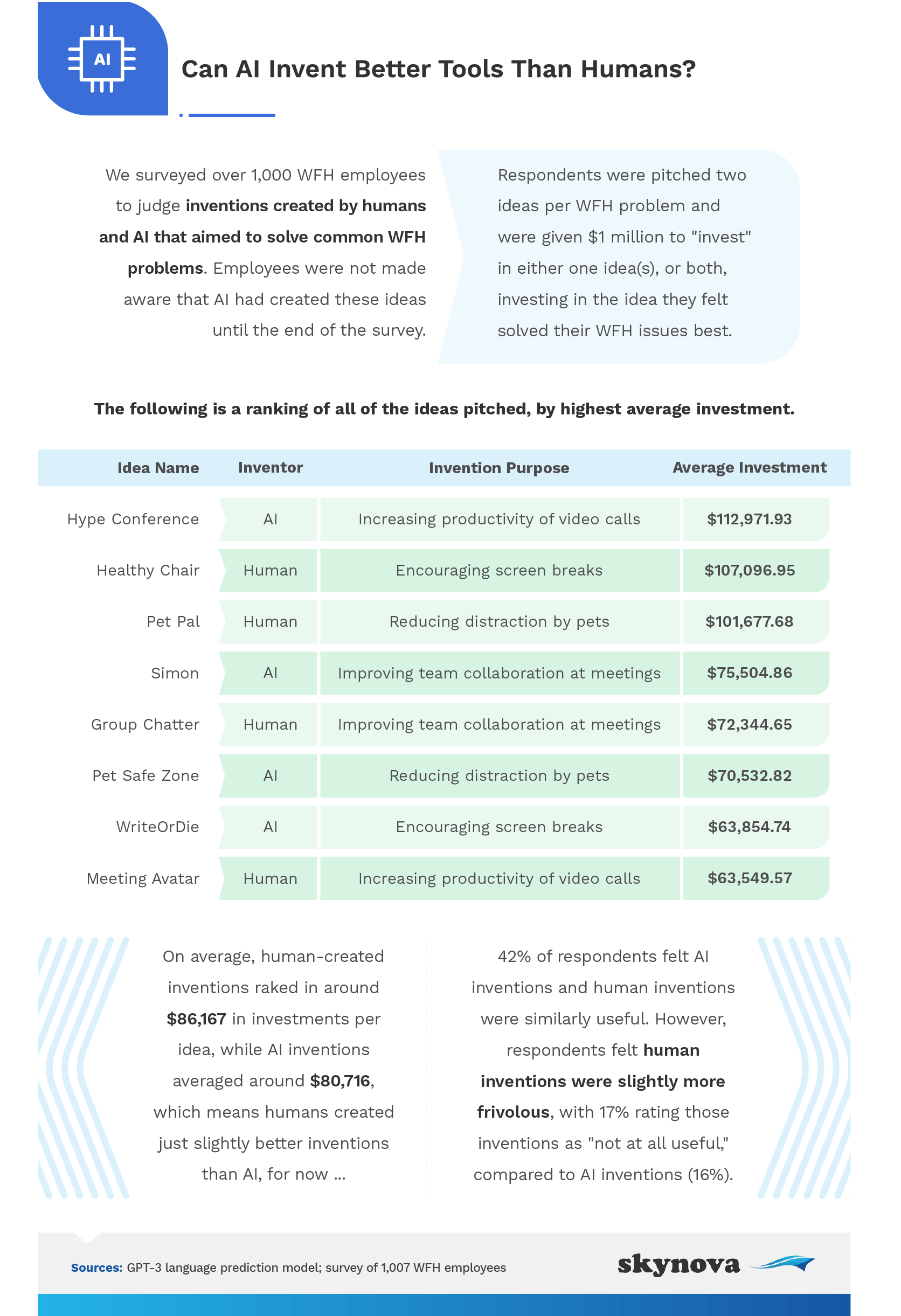
Depending on how you look at the investor response, one could argue that humans or AI were superior. If you're looking at which invention received the most money overall, AI would win. Their invention of the "Hype Conference," designed to increase productivity of video calls, received an average investment of $112,971.93 - more than any human-invented solution received.
On the other hand, the human-created inventions generally received an average of $86,167 per idea, while AI averaged just $80,716. From this point of view, human-created inventions were actually smarter, or at least more well-received. Bear in mind, however, that AI is still in its infancy, especially when compared to humans. In time, we may likely see this investment gap closing or perhaps widening in the direction of AI.
The first problem we asked humans and AI to solve - pet distractions - highlights just how superior AI has the potential to be. After all, the problem we're asking both types of creators to solve is really just a problem for humans. AI would never actually find itself distracted by pets in the first place. Nevertheless, both solutions and responses are listed below.
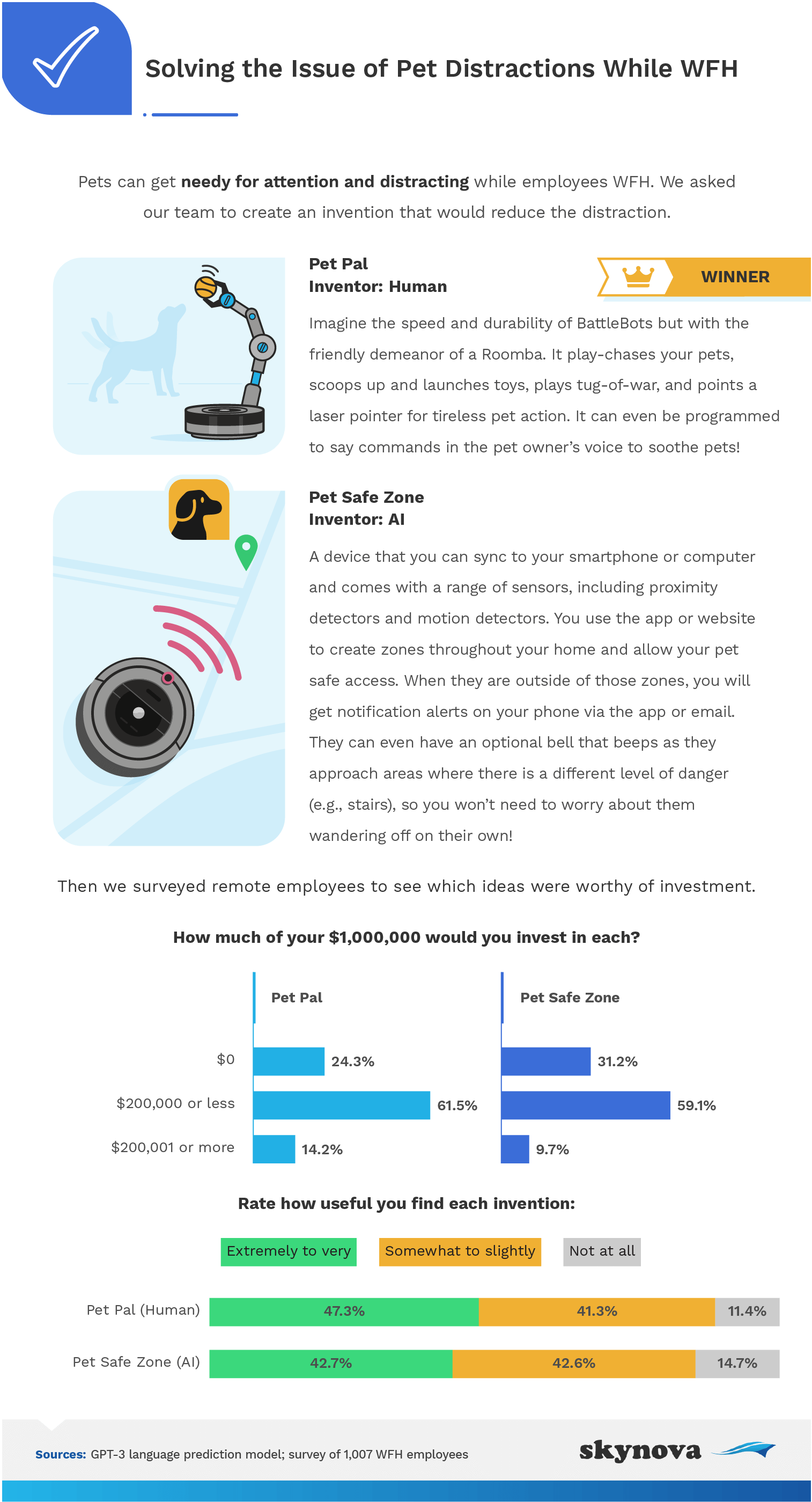
AI's solution to pet-based distractions was essentially a notification system - where certain zones could be created within the house - and each time the pet stepped out of that zone, the owner's phone would receive a notification. This, however, provides an additional distraction and doesn't necessarily provide a solution once the pet has stepped outside or inside your predetermined danger zones.
Perhaps a true understanding of how distracting pets can be was required to invent an appealing solution: The human-created invention provided more of an actual solution and ultimately received more funding from the audience. Their idea was to create a robot that would actually keep the pet entertained by doing things like launching toys, playing tug of war, and shining a laser. Most respondents found this invention more useful than AI's and were 46.4% more likely to invest $200,000 or more in the idea.
In many cases, remote meetings are tanking employee productivity. Letting them work uninterrupted has been shown to help their workflow, while the meetings themselves are often accomplishing very little. We asked humans and AI to come up with a solution to make the meetings worth their while.
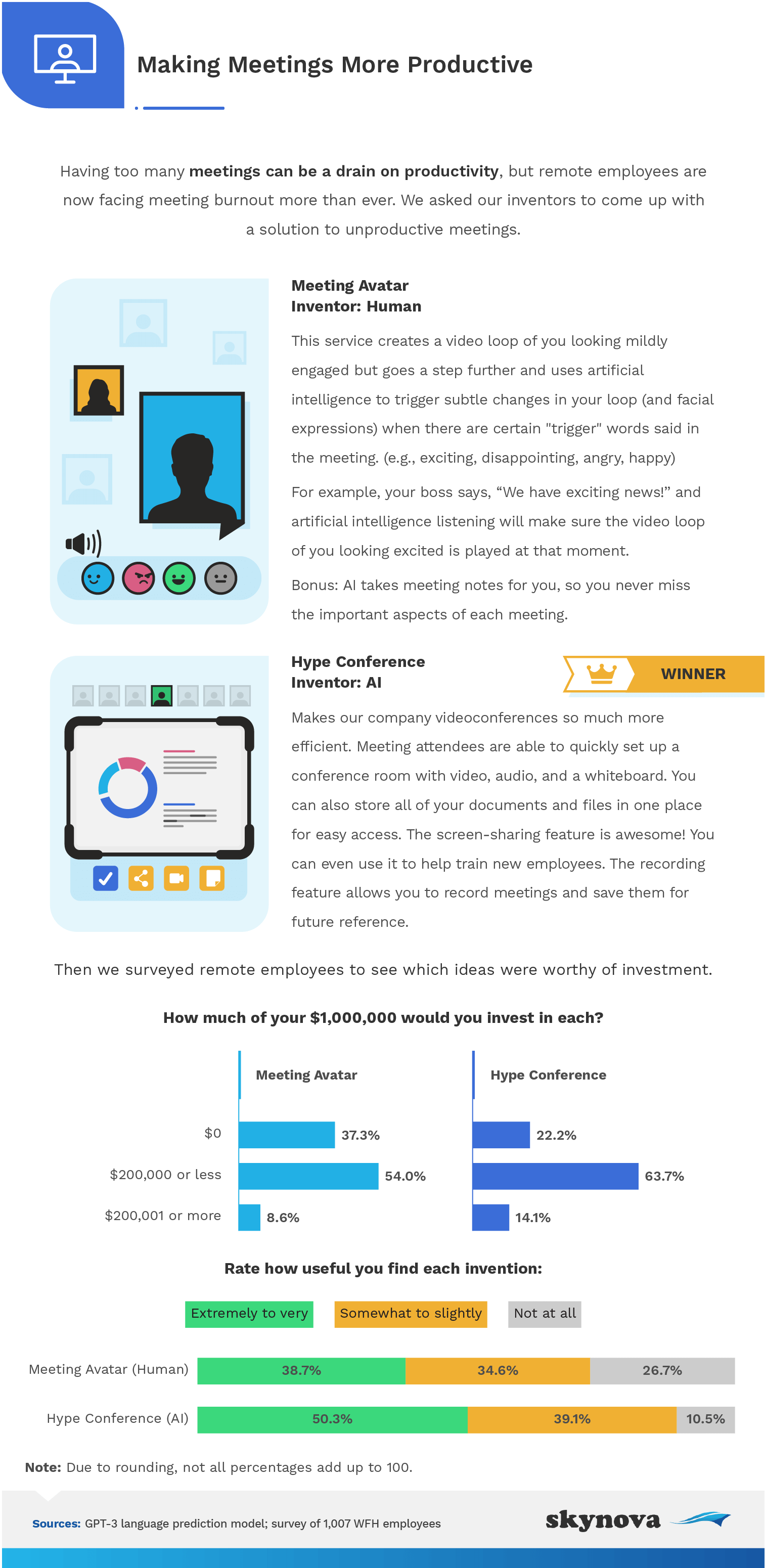
Humans seemed to have given up on the concept of making meetings more productive and instead invented a workaround. Their proposition was to essentially create an avatar of your own face that would know how to react appropriately to various cues. This avatar could seamlessly sub in for your meetings, leaving your real self free to get work done in the meantime. While 38.7% of respondents found this extremely to very useful, AI knocked it out of the park.
AI's invention for remote meeting productivity was the most heavily financed idea of all in this study, human and non. Their idea, "Hype Conference" made the meetings more efficient by creating a meeting space where everything the team would need would be handy. Shared documents, collaborative whiteboards, and screen-sharing features would all be easily accessible and in one place. Fourteen percent of respondents were willing to invest $200K or more in this idea.
Collaboration is notably more difficult when working remotely than in person. Once again, both humans and AI came up with their own solutions to the issue.
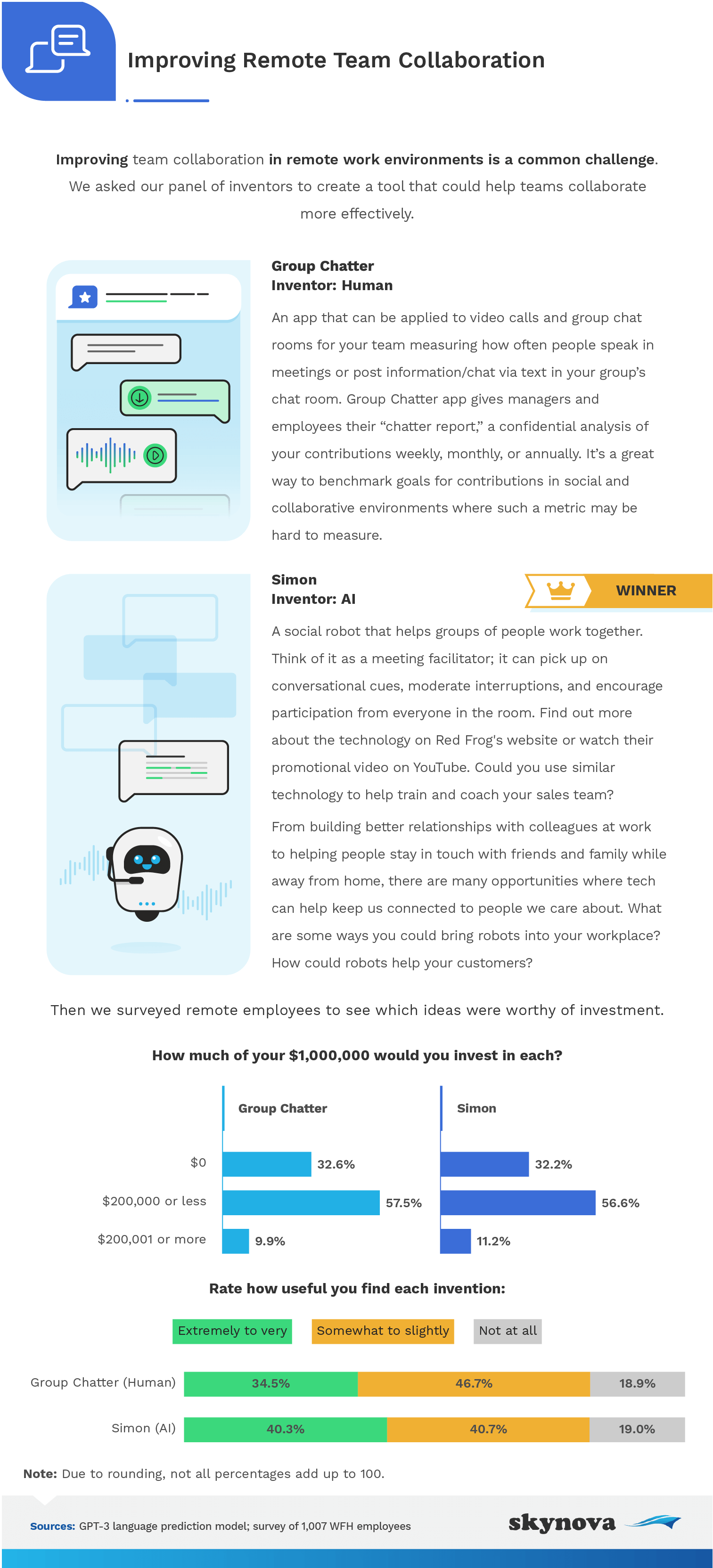
According to Entrepreneur.com, setting a recurring meeting increases collaboration because it sets a time in stone as opposed to repeatedly having to find a time that works for everyone. According to our human inventors, the solution is an app that will micromonitor employee contributions each meeting. Employees will then be able to have collaborative KPIs and benchmarks.
AI, on the other hand, invented "Simon," which was a social robot that would work as a meeting facilitator. It would be able to "pick up on conversational cues" and even help people build relationships with one another. Respondents were more likely to both find this idea extremely useful and to heavily invest in its production.
Taking screen breaks is a practice we'd all like to implement more of in our daily routine. That said, demands of the workplace and modern habits make this easier said than done. We asked humans and AI to come up with some ideas to help employees give their eyes a rest from the screen.
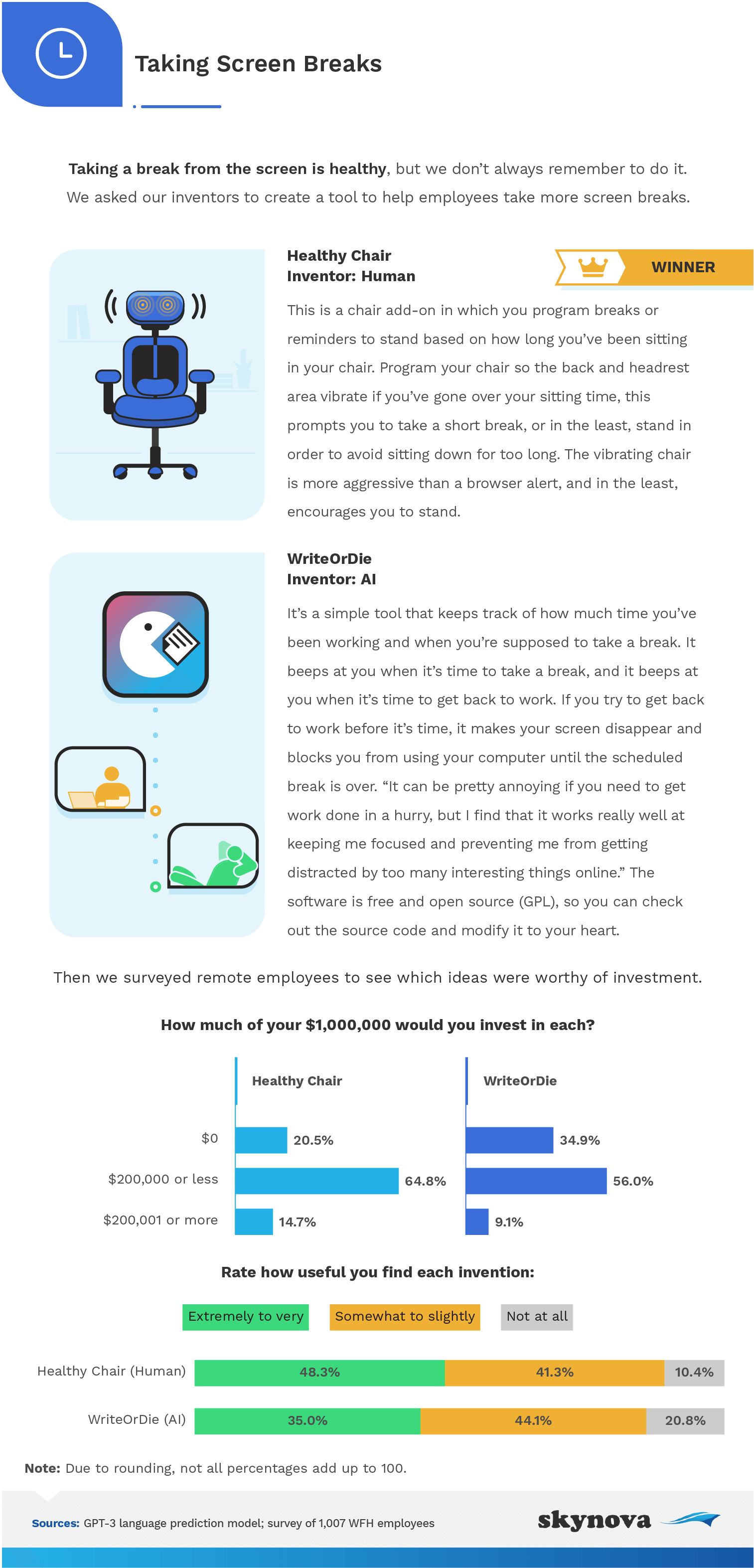
Perhaps, deep down, AI couldn't find the motivation to help us step away from AI. Humans were much better able to invent a solution to avoiding screens. Their idea? The Healthy Chair - a chair that would be able to monitor how long a person had been sitting and give a gentle reminder of when it was time to stand up and walk away - and presumably put the phone and/or computer down as well.
AI, on the other hand, came up with something that already exists on most smartphones and doesn't necessarily encourage taking screen breaks. Their idea, the "WriteorDie" would keep track of your screen time and generate beeps when it was time to take a break. This idea was less likely to be found helpful and less likely to receive substantial investments from respondents.
Modern business problems require modern business solutions, but that doesn't necessarily mean artificial intelligence is the best tool in our tool box, especially when solving very human problems. Humans were able to come up with ideas that often beat the AI competition, though AI provided some useful solutions as well. Some of those AI ideas were money-makers, according to the enthusiastic responses from the remote workforce we surveyed. With some human intervention, we were able to generate numerous ideas to help the average WFH worker solve their everyday work problems, though not all of them were exactly market-ready. The big takeaway here is that AI can be a useful creative tool when brainstorming ideas or thinking about solutions to complex, multifaceted problems that require a little more creative inspiration than usual.
Skynova's primary purpose is to help small businesses get paid faster. Skynova offers easy to use but highly professional templates and accounting services to help other businesses, both small and large, receive the payments they need to keep business running smoothly. Skynova can provide the professionalism, affordability, and reliability that any thriving business needs.
Inventions:
We had a panel of creatives pitch simple inventions to solve everyday work-from-home issues, ranging from pet distractions to team collaboration. We used specific prompts to aid the inventors, and we used those same prompts as well as some variations of those prompts with an open-source GPT-3 model, a third-generation language prediction model, in order to generate AI-made inventions. Then, we surveyed over 1,000 respondents who were employed and work from home in order to see which inventions they would "invest" in using a hypothetical $1 million. They also rated each invention on its usefulness.
Survey:
We surveyed 1,007 respondents who were employed and work from home in order to explore how human ingenuity measures against AI-generated products. Respondents ranged in age from 24 to 61 with a mean age of 38. Forty-eight percent of our respondents identified as female, and 52% identified as male.
Survey data has certain limitations related to self-reporting. These limitations include telescoping, exaggeration, and selective memory. We didn't weight our data or statistically test our hypotheses. This was a purely exploratory project that examines how human creativity does against AI in terms of interest and usefulness.
Want to see what solutions your fellow humans can come up with to these problems? You're welcome to share this article for inspiration; just be sure your purposes are noncommercial and that you link back to this page so its contributors can receive proper credit for their work.